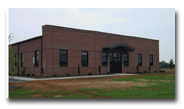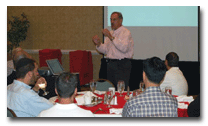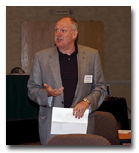Bruno Ameline and Evelyne Cholet, the President and the Secretary General of UCMTF (French Textile
Machinery Manufacturers Association), report on the French textile machinery in 2005 and analyze
the main trends that are shaping the future developments.
Can you tell us of UCMTF’s goals?
Ameline: UCMTF groups around 35 textile machinery manufacturers from France; their total
export is close to 1 billion Euros ($1.2 billion). Our main goals are:
* To share information and implement services among our members, make our network of small
and middle-size enterprises (SMEs) very efficient and proactive.
* To provide logistical support to our members to help them exhibit at the shows we have
selected and to enhance their marketing and sales efforts through seminars. In particular, we
organize French pavilions in these exhibitions and seminars in countries of particular interest for
us. In 2006 we are organizing national pavilions at Textile Expo Uzbekistan, at Premiere Vision
next September in Paris and at CITME (Beijing) and two seminars, in Brazil and in Pakistan. We also
support our members at ITM in Istanbul.
* To promote our sector in order to attract young engineering and managerial talents. We
focus our efforts towards the best universities and every two years we organize a forum to which we
invite textile students from all over France. This effort could be better coordinated with the
textile industry; we are working to that purpose.
* To control the number of exhibitions worldwide. As the market shifts toward Asia and
Turkey, it is more important than ever to choose among many offers and limit the number of
machinery shows. This is done in close cooperation with all other European textile machinery
associations regrouped in CEMATEX, which owns the ITMA brand and organizes both ITMA and ITMA ASIA.
Can you report on your member activities in 2005?
Cholet: In 2005, with a total amount of nearly 1 billion euros, our members registered a
slight slowdown (in euros) compared to the previous year. The 3-percent drop is in line with the
market evolution, which means we have maintained our market share. A geographical analysis shows
that Western Europe, with the exception of Italy, continues to decline but still represents 34
percent of the French exports. Growth remained in Asia (30 percent of our exports) despite a
slowdown in China, which was more than offset by very good deliveries in Japan, India, Pakistan,
Malaysia and Indonesia. About 10 percent of our sales were in Turkey where we rank fourth among
exporters, a slight decrease we consider a pause rather than a new trend. We registered very
significant increases in Central and Eastern Europe (7 percent of our sales) and North America (9
percent). North Africa was rather stable at 6 percent as Central and South America at 3 percent
,where Brazil and to a certain extent Argentina seem quite active.
By sector of activities, French machinery is not representative of the global markets, as our
companies are not active in all production processes. Weaving and weaving preparation are very
important for us with about 42 percent of our sales, then knitting and making-up with 19 percent,
spinning and yarn related activities 10 percent, nonwovens 8 percent, dyeing and finishing 7
percent, accessories and miscellaneous 13 percent.
How do you compare with your competitors?
Ameline: France accounts for close to 7 percent of the worldwide textile machinery sector not
including the production of Chinese manufacturers for the local market, on which we have no clear
and reliable data.
Anyhow, Western Europe remains the main place for machine manufacturers and exporters, and
French manufacturers are the most important after Germany, Italy and Switzerland. From other parts
of the world only Japan is ahead of us. This global market share is not really representative of
our strengths in various specific activities and geographical sectors. In France, we do not have
big diversified groups in textile machinery but state of the art, very active specialized SMEs,
leaders in their sectors of application like long fibers spinning, preparation of yarns, dobbies,
jacquard, dyeing and finishing, card clothing, ultrasonic cutting, recycling, air conditioning,
airlay and the fast growing nonwovens.
Can being an SME be a weakness in a global market?
Ameline: Of course, when one is not a large diversified group, it may look difficult to
market one’s machines in many different continents and countries, to maintain service so far from
one’s home bases but, as most of our members have already specialized on some application sectors,
they can focus on some countries which represent most of the textile market for their specific
applications. With the shift of the market to Asia (China and India, in particular), I believe our
SMEs can focus on less than 10 countries and dedicate their efforts on these. It is a big challenge
for our member companies to dedicate resources outside Europe to such remote countries. It means a
clear choice between specialization or becoming part of global groups. I believe the strategy of
staying independent may work perfectly, as often family-owned SMEs can work very well if the
decision to specialize is clear and all the consequences taken accordingly.
Can such companies offer the necessary services to their customers?
Ameline: I do not think the customers from the new Asian markets are as much service oriented
as the customers we have known from Europe or from the US.
These customers are cost oriented, they invest to produce what the market demands today, and
they look for short paybacks and quick money. Most of these customers may not request as much
service as the customers looking for long-term partnerships with their suppliers.
What trends do you forecast for the next few years?
Ameline: I expect that a significant risk for most of the textile machinery application
sectors is overcapacity, hence limited sales for Western machinery manufacturers.
* Overcapacity can be structural.
In some mature segments (geographical or application sectors), the machine productivity
increase is at least at par with the growth of textile consumption and breakthrough innovation is
rare. These markets are mostly cost driven. In the long staple-spinning sector, which I personally
know well, overcapacity is estimated between 5 and 25 percent! There is quite a lot of transactions
in second-hand machinery and upgrading of existing lines. Investments in new machines can only be
justified by real innovations that enable our customers to offer new products or reduce production
costs decisively.
Structural overcapacity can also derive from regional duplication.
In the 90s, investments have been made in Western Europe and in the US, but also in the new
producing countries in Asia in parallel. Investments in China, for example, have grown at an annual
pace of 20 to 40 percent during several years. This has led to unnecessary capacity in many sectors
and will undoubtedly result in some restructuring. China itself has to rationalize its own textile
machinery industry in such sectors as knitting and nonwovens before investments can rebound. As the
new machine manufacturers in China and India try to enter the market, which is dominated so far by
Western manufacturers, the result is greater overcapacity.
* Overcapacity can also be cyclical.
In such sectors as weaving, investments have been very important in 2002 and 2003, and then
the sector had to live with lower sales. The same applies to the nonwoven sector even though new
product needs added production capacity. With this overall trend of overcapacity, I do not think we
can expect a global increase in machinery investments but I am not pessimistic either. I do believe
2006 will show a global stability as new markets do emerge. While I think China still has to
restructure its textile sector and we will continue to face increasing competition from local
manufacturers in this market, India will grow as many projects are close to completion. Turkey may
rebound. I also have good feelings about the US market and the new European countries.
Do you forecast more mergers and acquisitions in the textile machinery?
Ameline: Our industry has already been through some major restructuring and it will continue.
Some major groups have developed recently mainly through some major acquisitions. European
manufacturers will have to face fierce competition from China and other new players. There are many
Chinese manufacturers as we said. Many of these will disappear but a few will probably become
majors, by internal growth and possibly also through mergers and acquisitions.
Chinese companies have a cost advantage and they will retain it even compared with European
manufacturers producing in China. It will be so for quite a while as organization will remain
different and laws applied differently in China. For the future, I see two main classes of
manufacturers: large international groups competing for large volume technologies and I expect some
Chinese and Indian groups to be part of these. In the second type, we will find quite a number of
specialized manufacturers; niche markets specialists that will focus on some particular
applications but with less competition. These specialists can be very successful. Manufacturers
have to choose in which group they want to be or can be and to take the necessary steps to
implement a consistent strategy.Interview
Courtesy Of the French Textile Machinery Manufacturers Association
September 12, 2006

 Advanced Testing Instruments Corp. (ATI) has moved its North American corporate
Advanced Testing Instruments Corp. (ATI) has moved its North American corporate




